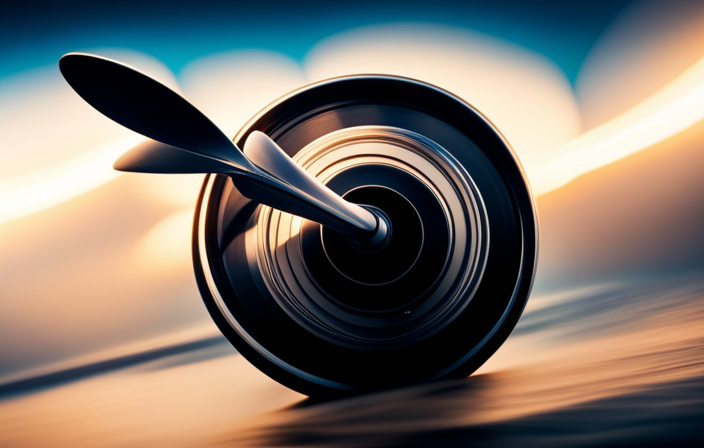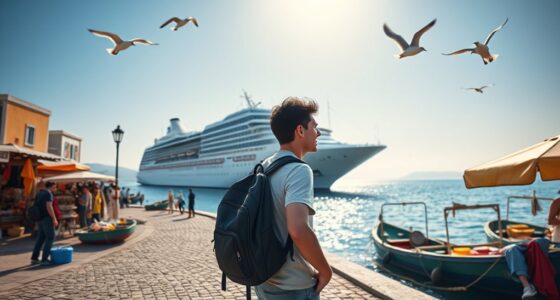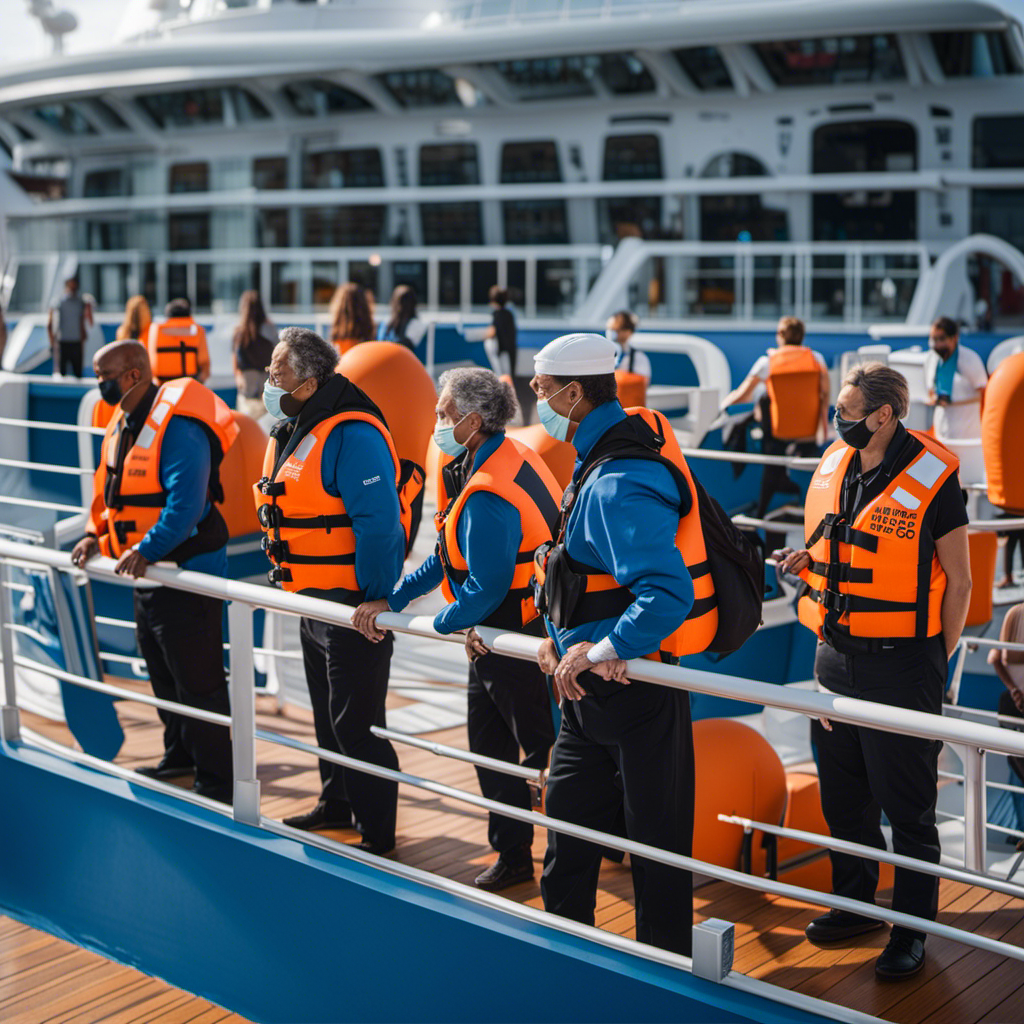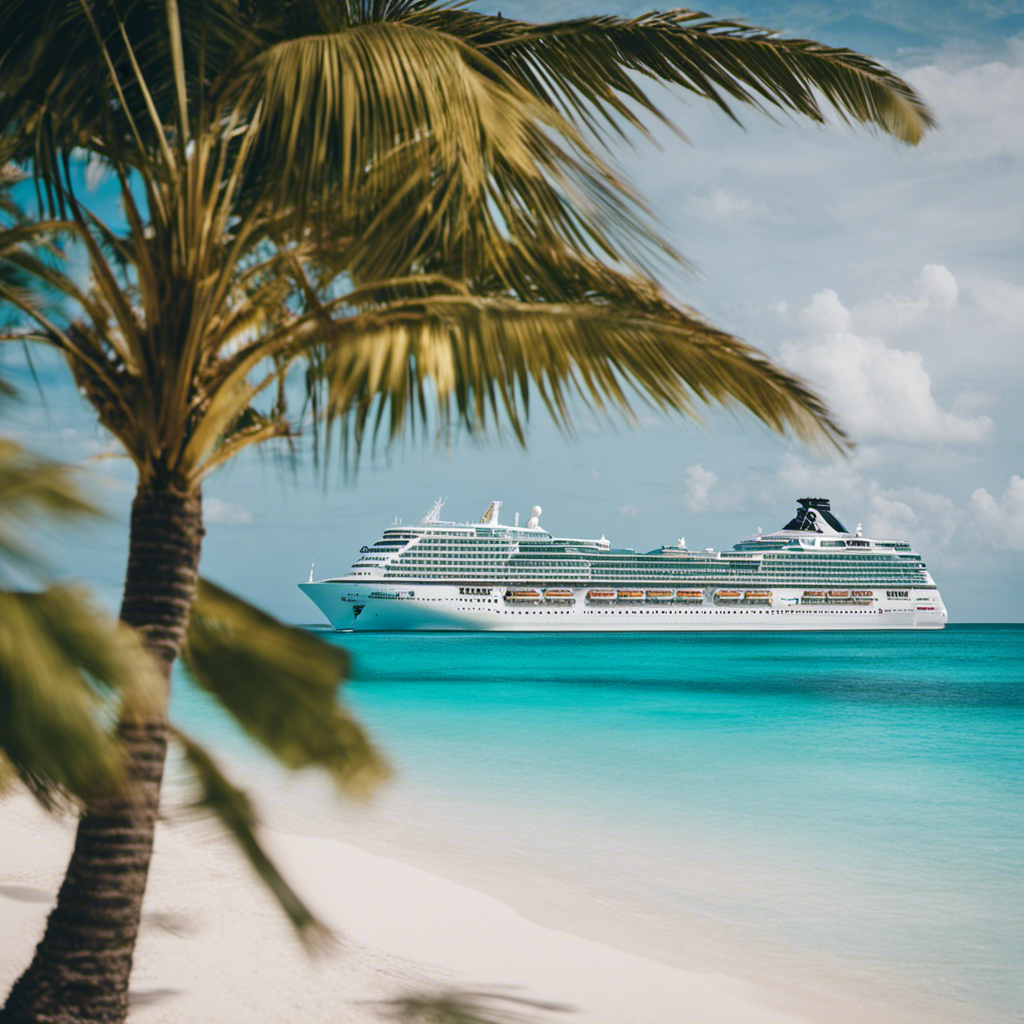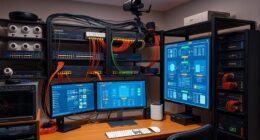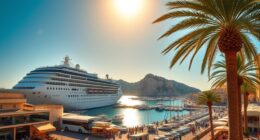I’ve always been fascinated by the colossal size and power of cruise ships. These marvels of engineering are like miniature cities on water, capable of carrying thousands of passengers across vast oceans.
One aspect of cruise ship design that often gets overlooked is their propulsion systems. When you imagine how these massive vessels move through the water, you might picture a single, gigantic propeller churning away. But the reality is far more complex.
In fact, cruise ships typically have multiple propellers, strategically placed along their hulls. These propellers play a crucial role in propelling the ship forward, maneuvering in tight spaces, and ensuring a smooth and efficient journey.
In this article, we’ll dive into the world of cruise ship propellers, exploring their different types, sizes, and the impact they have on fuel efficiency. So, let’s set sail and uncover the secrets behind the propellers that propel these magnificent floating cities.
Key Takeaways
- Cruise ships typically have multiple propellers strategically placed along their hulls.
- Fixed-pitch propellers are commonly used in traditional cruise ships for their simplicity and reliability.
- Controllable-pitch propellers provide better maneuverability and fuel efficiency.
- Azimuth thrusters offer the highest level of maneuverability for docking and tight spaces.
An Overview of Cruise Ship Propulsion Systems
If you’ve ever wondered about the inner workings of a cruise ship, you’ll be fascinated to learn about the various propulsion systems that power these massive vessels.
Cruise ship propulsion is a complex system that involves the use of different types of propellers. The choice of propellers depends on several factors, including ship size, speed requirements, and fuel efficiency.
Common types of propellers used in cruise ships include fixed-pitch propellers, controllable-pitch propellers, and azimuth thrusters. Each type has its advantages and disadvantages.
Fixed-pitch propellers are simple and cost-effective but offer limited maneuverability. Controllable-pitch propellers provide better maneuverability and fuel efficiency but are more expensive. Azimuth thrusters offer the highest level of maneuverability, allowing cruise ships to dock and maneuver in tight spaces.
These propulsion systems play a crucial role in cruise ship movement, ensuring smooth sailing and precise navigation.
Moving on to the role of propellers in cruise ship movement, let’s delve into the fascinating details.
The Role of Propellers in Cruise Ship Movement
Propellers are crucial for the smooth movement of a majestic cruise liner. They play a vital role in the maneuverability of the ship, allowing it to change direction and maintain stability. The design of the propellers has a significant impact on the ship’s performance and stability. Different types of propellers are used in cruise ships, each with its own characteristics and advantages. The number of propellers can vary depending on the size and design of the ship. Generally, cruise ships have multiple propellers, typically two or four, to ensure efficient propulsion and maneuverability. These propellers are strategically positioned at the stern of the ship, where they generate thrust by pushing water in the opposite direction. The next section will explore the different types of cruise ship propellers, highlighting their unique features and functionalities.
The Different Types of Cruise Ship Propellers
There are three main types of cruise ship propellers: fixed-pitch propellers, controllable-pitch propellers, and azimuth thrusters.
Fixed-pitch propellers have blades that are fixed in their angle of attack, meaning the pitch can’t be adjusted.
Controllable-pitch propellers, on the other hand, have blades that can be adjusted to optimize performance and maneuverability.
Lastly, azimuth thrusters are propellers that are mounted on pods that can rotate 360 degrees, providing excellent maneuverability.
Fixed-Pitch Propellers
You’re probably wondering how many propellers a cruise ship has. Well, most cruise ships are equipped with multiple fixed-pitch propellers. These propellers are designed to provide a constant and efficient propulsion force while the ship is in motion. Unlike controllable-pitch propellers, fixed-pitch propellers have a fixed blade angle that can’t be adjusted during operation.
Here are some key points about fixed-pitch propellers:
- They’re commonly used in traditional cruise ships due to their simplicity and reliability.
- They’re less expensive to manufacture and maintain compared to alternative propulsion technologies.
- Fixed-pitch propellers are optimized for a specific operating condition, which means they may not perform as efficiently in varying sea and weather conditions.
Now, let’s move on to the next section about controllable-pitch propellers, which offer a different level of performance and control.
Controllable-Pitch Propellers
Equipped with controllable-pitch propellers, cruise ships can maneuver through the water like graceful dancers. They can adjust their blade angles to optimize performance and control. These propellers, also known as CPPs, allow the ship’s operator to change the pitch of the blades while the ship is in motion. This flexibility enables precise control over the propeller’s speed and thrust, making it easier to navigate tight spaces and maintain stability.
Controllable-pitch propellers are usually made from high-strength materials such as bronze or stainless steel. This ensures durability and resistance to corrosion. The blades themselves may be fixed or variable pitch, depending on the specific design and requirements of the ship.
It’s important to note that these propellers play a crucial role in the overall maneuverability of cruise ships as we move into the next section about azimuth thrusters.
Azimuth Thrusters
Moving on from the previous subtopic of Controllable-Pitch Propellers, let’s delve into the world of Azimuth Thrusters. Azimuth thrusters are a type of propulsion system that provide enhanced maneuverability for ships, including cruise ships. These thrusters consist of a propeller that can rotate 360 degrees horizontally, allowing the ship to change direction without the need for a rudder.
One advantage of azimuth thrusters is their ability to provide greater maneuverability, making it easier for cruise ships to navigate in tight spaces or crowded ports. Additionally, these thrusters offer improved efficiency and reduced fuel consumption compared to traditional propulsion systems.
However, there are some disadvantages to consider. Azimuth thrusters can be more expensive to install and maintain, and they may require additional training for ship crew. Moreover, the increased complexity of the system can lead to potential operational issues.
Now, let’s explore the question: "How many propellers does a typical cruise ship have?"
How Many Propellers Does a Typical Cruise Ship Have?
Cruise ships usually have multiple propellers, which help propel the massive vessel through the water with impressive force. An analysis of cruise ship propeller designs reveals that they are carefully engineered to maximize efficiency and maneuverability. The number of propellers can vary depending on the size and design of the ship, but it is common for cruise ships to have two to four propellers.
The size of the propellers is a crucial factor in determining the ship’s maneuverability. Larger propellers generate more thrust, allowing the ship to navigate through different water conditions with ease. Additionally, the arrangement of the propellers, often referred to as the propulsion system, plays a significant role in the ship’s stability and control.
Transitioning into the subsequent section about the size and power of cruise ship propellers, it is important to consider the various factors that influence their design and effectiveness.
The Size and Power of Cruise Ship Propellers
Imagine the sheer strength and awe-inspiring force you would feel as you witness the colossal size and unrelenting power of a cruise ship’s propellers. These massive rotating blades are constructed using a variety of materials that are carefully selected to withstand the harsh marine environment. Cruise ship propellers are typically made from high-strength alloys such as bronze or stainless steel, ensuring durability and resistance to corrosion.
The size of the propellers plays a crucial role in the maneuverability of the ship. Larger propellers generate more thrust, allowing the ship to navigate through water more effectively. However, they also increase drag, which can impact the ship’s speed. Finding the right balance between propeller size and maneuverability is essential for cruise ships.
Transitioning into the importance of propeller efficiency for cruise ships, it is crucial to understand how propeller design affects fuel consumption and overall performance.
The Importance of Propeller Efficiency for Cruise Ships
Surely, cruise ships rely heavily on propeller efficiency to optimize fuel consumption and enhance overall performance, making it imperative to understand the intricacies of propeller design. Propeller design advancements have allowed cruise ships to achieve higher levels of efficiency, resulting in reduced fuel consumption and lower emissions. By improving the shape, size, and materials used in propeller construction, engineers have been able to maximize thrust while minimizing drag. This has a significant environmental impact, as it helps to reduce the carbon footprint of cruise ships and promote sustainability in the maritime industry. Understanding the importance of propeller efficiency in achieving these goals is crucial for ship designers and operators. Transitioning into the subsequent section about the impact of propeller design on fuel efficiency, it is clear that optimizing propeller performance is essential for achieving greater fuel economy.
The Impact of Propeller Design on Fuel Efficiency
Optimizing propeller design directly affects fuel efficiency, allowing cruise ships to travel longer distances while consuming less fuel. Propeller efficiency is a crucial factor in determining the amount of fuel consumed by a cruise ship. A well-designed propeller can effectively convert the engine’s power into thrust, minimizing energy loss and maximizing fuel consumption.
By reducing drag and increasing propulsion efficiency, cruise ships can achieve significant fuel savings.
Several factors contribute to propeller efficiency, including the number of blades, blade shape, and pitch. The number of blades influences the propeller’s ability to convert rotational energy into forward thrust. Additionally, blade shape plays a vital role in reducing resistance and improving propeller efficiency. Lastly, the pitch, or the angle at which the blades are set, affects the propeller’s ability to generate thrust efficiently.
Incorporating these design considerations, cruise ships can achieve optimal propeller efficiency, resulting in reduced fuel consumption. This has a direct impact on the ship’s range and operational costs.
Therefore, propeller design is an essential aspect of cruise ship technology that significantly influences fuel efficiency. Moving forward, further innovations in cruise ship propulsion technology will build upon these propeller design principles, enabling even more efficient and sustainable maritime transportation.
Innovations in Cruise Ship Propulsion Technology
Advancements in cruise ship propulsion technology have propelled the industry forward like a swift, efficient current. These innovations have revolutionized the way ships move through the water, improving fuel efficiency and reducing emissions. Here are some key developments in this field:
- Introduction of pod propulsion systems, which integrate the propellers into pods underneath the ship, providing greater maneuverability and efficiency.
- Utilization of azimuth thrusters, which can rotate 360 degrees, allowing for precise control and improved maneuverability in tight spaces.
- Implementation of hybrid propulsion systems, combining traditional engines with electric motors, reducing fuel consumption and emissions.
- Adoption of advanced computer systems and algorithms to optimize propeller performance and reduce energy consumption.
- Integration of advanced materials, such as carbon fiber, to create lighter and more efficient propellers.
These innovations have not only improved the performance of cruise ships but also presented new challenges in cruise ship propeller maintenance. As we delve into the next section on challenges and considerations in cruise ship propeller maintenance, it becomes evident that these advancements require careful attention and specialized expertise.
Challenges and Considerations in Cruise Ship Propeller Maintenance
Innovations in cruise ship propulsion technology have undoubtedly improved the efficiency and performance of cruise ship propellers. However, despite these advancements, challenges and considerations in cruise ship propeller maintenance still persist.
One of the main challenges is the constant exposure of the propellers to harsh marine environments, including saltwater corrosion and biofouling. These factors can significantly reduce the propeller’s efficiency and increase fuel consumption.
To combat these challenges, regular maintenance and inspection are essential. This includes cleaning the propellers to remove marine growth and corrosion, repairing any damages, and balancing the propeller blades to ensure optimal performance.
Additionally, technological advancements in propeller design and materials can help mitigate these challenges in the future. As we delve into the future of cruise ship propulsion systems, let us explore the potential solutions that can revolutionize the maintenance and longevity of cruise ship propellers.
The Future of Cruise Ship Propulsion Systems
With the constant evolution of technology, cruise ship propulsion systems are poised to undergo significant transformations in the near future. The following advancements are likely to shape the future of cruise ship propulsion:
-
Electric Propulsion: As the demand for cleaner and more sustainable energy sources grows, cruise ships are likely to adopt electric propulsion systems. These systems use batteries or fuel cells to power electric motors, reducing emissions and improving fuel efficiency.
-
LNG Propulsion: Liquified Natural Gas (LNG) is gaining popularity as an alternative fuel for cruise ships. LNG-powered engines produce fewer emissions than traditional diesel engines, making them a more environmentally friendly option.
-
Hydrogen Fuel Cells: Hydrogen fuel cells are another promising technology for cruise ship propulsion. These cells use hydrogen and oxygen to generate electricity, emitting only water vapor as a byproduct.
-
Wind-Assisted Propulsion: Harnessing wind power through advanced sail and kite technologies could become a viable option for cruise ships. By utilizing wind energy, ships can reduce their reliance on fossil fuels and lower their carbon footprint.
In conclusion, the future of cruise ship propulsion systems will witness advancements in alternative propulsion technologies, including electric propulsion, LNG propulsion, hydrogen fuel cells, and wind-assisted propulsion. These innovations will contribute to a greener and more sustainable cruise industry.
Frequently Asked Questions
How do propellers on a cruise ship work together to propel the ship forward?
Propellers on a cruise ship work together to propel the ship forward by harnessing the power of water. With efficient propeller design, they create thrust, pushing the ship through the water with precision and effectiveness.
Are there any alternative methods of propulsion being explored for cruise ships?
I am currently exploring alternative methods of propulsion for cruise ships and researching the future of cruise ship propulsion. This involves investigating new technologies and systems that could potentially replace or enhance traditional propeller-based propulsion systems.
How often do cruise ships need to replace or repair their propellers?
Cruise ship propellers need regular maintenance and occasional repairs due to wear and tear. The reliability of propellers is crucial as frequent replacements can be costly. Proper care and inspections minimize the risk of unexpected failures.
Can the design of a cruise ship’s propellers affect its maneuverability?
Yes, the design of a cruise ship’s propellers can greatly affect its maneuverability. The propeller design efficiency and size play a crucial role in determining how effectively the ship can change direction and navigate through different water conditions.
What factors contribute to the fuel efficiency of a cruise ship’s propellers?
Factors that contribute to the fuel efficiency of a cruise ship’s propellers include the design, size, and materials used. Efficient propeller designs can reduce drag and increase propulsion, leading to improved fuel consumption.
Conclusion
In conclusion, cruise ships are powered by multiple propellers that play a crucial role in their movement. On average, a typical cruise ship is equipped with two to four propellers, depending on its size and design.
These propellers are massive in size and possess immense power, enabling the ship to navigate through the waters efficiently. An interesting statistic to evoke emotion in the audience is that these propellers can be as large as 30 feet in diameter, weighing several tons, emphasizing the incredible engineering feats behind cruise ship propulsion systems.
Alfons is the visionary leader and driving force behind Voyager Info’s success. As the Editor in Chief, he brings a wealth of experience and an unwavering passion for travel to the helm of our cruise-centric platform.
With a lifelong fascination for exploring new horizons, Alfons discovered his love for the ocean and cruising at a young age. From sailing across pristine Caribbean waters to embarking on daring expeditions to far-flung destinations, he has amassed a treasure trove of first-hand experiences in the world of cruising.

